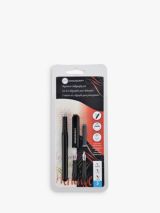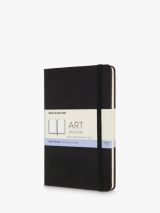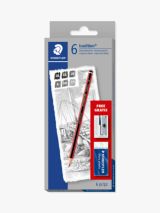The beginner’s guide to journaling
Keeping a journal can be a great step on the road to wellness. Our experts explain everything you need to know to get started
If you’re after a new strategy to add to your self-care toolkit, try putting pen to paper. Research has linked journaling with sounder sleep, better health and improved emotional wellbeing – according to US researchers, just three to five 15-20 minute sessions of expressive writing can relieve stress, reduce blood pressure and improve the immune system, lung and liver function.
‘Keeping a journal allows you to reflect on your thoughts and emotions in a safe and private space,’ explains journaling expert Helen Colebrook, author of Journal With Purpose. ‘You might not feel ready to talk about your feelings, or even properly understand them yourself, but writing your worries down can help you to process your thoughts and gain a fresh perspective.’
‘By creating a mindful journaling practice, we can develop the habit of “feeling into” the problem, being curious rather than forcing an outcome,’ agrees business coach Nicola Wilkes, founder of Seriously Stylish Business. ‘When we relax into the writing process, we “move” the problem from our minds to paper, which leaves us feeling lighter, happier and more in control. Very often, we find the solution in what we write.’
‘You can use your journal to plot out your dreams for the future and keep track of day-to-day tasks and routines, so you stay on top of things that need doing while keeping your focus on positive things ahead,’ Helen adds.
‘Journaling is a powerful visualisation tool,’ Nicola agrees. ‘Putting pen to paper can make the difference between having a pipe dream and actually making it happen. When we journal regularly, it keeps us fully connected to what we truly desire or are working towards, personally or career-wise.’
In the flow
While you can approach it in a number of different ways, the principles of journaling are simple. ‘Essentially, journaling is a way of transposing our thoughts onto paper,’ explains Nicola. ‘Journaling enables all those thoughts that you don’t normally acknowledge, or give enough “airtime” to, to flow naturally onto the page. You can bring forth ideas, goals and dreams you never knew were swirling around in your mind: it’s an amazing way to access your innermost thoughts.’
‘A free flow journal is a notebook that you use to document all the thoughts that are circling around in your mind,’ Helen adds. ‘It’s a place to write freely, without judgment. I’m not always sure what is going to come out – I just let my mind wander and capture as many of those thoughts as I can. It helps me deal with troubling thoughts and is also how I’ve come up with some of my best ideas. Our minds are so busy, it can be difficult to tap into the subconscious thoughts that may have been masked by more pressing issues, and listen to the ideas that are bubbling along quietly in the background.
‘To start, just grab any notebook and set a timer for 10 or 15 minutes. Don’t plan what you are going to write; just listen to your mind and get everything down. It’s well worth trying to set a small, regular chunk of time aside each day. Start off simple and then reflect on which type of journaling is bringing you the most joy. Don’t be intimidated by the beautiful pages you see on social media – as long as your journal works for you, it is absolutely perfect.’
Bite the bullet
Part diary, part life-planner, the bullet journal method provides you with a flexible, visual way to plan and track everything that is important to you – from marathon training to meal prep. ‘I have always found that traditional planners aren’t flexible enough to manage all of the different things that I need and want to do,’ says Helen. ‘A bullet journal is a planning system that you create yourself in a notebook. I use mine to plan out my life goals, project work, client commissions, monthly goals and daily task lists. I also use it as a healthy eating and exercise tracker, and a reading log. I find it really beneficial to set my plans out on paper – when I sit down with my bullet journal, I switch off from the electronic world and take the time to reflect on all the things that I want to work on, not just the daily demands and tasks that come my way.’
Dotted or squared notebooks tend to make the best bullet journals. You’ll find lots of useful hints and tips about the bullet journaling system on the official bullet journal website – and plenty of visual inspiration on Instagram and Pinterest.
Art attack
Blank page giving you a bad case of writer’s block? Art journaling can help you access your thoughts and feelings from another perspective. ‘An art journal lets you relax and express your emotions through colour and form,’ says Helen. ‘You don’t have to create an intricate piece of art – simply play with colours, paint, collage or other mixed media. You’ll find lots of inspiration on Pinterest and YouTube. There are also some fantastic art journaling groups on Facebook – they often release prompts and challenges that you can follow along with.’
Show a little gratitude
Writing in a gratitude journal reduces stress, improves sleep and helps you to cultivate a more optimistic outlook. ‘A gratitude journal is a place to document all the things that you are happy to have in your life,’ Helen explains. ‘I write a couple of lines in mine every evening – things like a fresh breeze coming through the window, hearing the birds sing, funny conversations with family or friends, TV programmes that made me laugh, a great book, the smell of fresh sheets or having enough food in the house. When you are going through a tough time, a gratitude journal helps you to focus on the positive. It also encourages you to notice more positive things, making you feel more happy and appreciative.’
Try noting down three things you are grateful for in your journal – or even the Notes app on your phone – before you go to bed tonight.
Go for goals
Still not sure where to start? ‘Journaling can be daunting to begin with, as it’s easy to overthink it,’ Nicola says. Try her four-step process to help you access your inner goal-getter:
- Clear the swirl – this is your chance to get anything that is bothering you down on paper, so it’s out in the open and you’ve confronted it.
- Do a ‘brain dump’ of your mental to-do list. I use bullet points – this makes me feel like I’m being practical. This is another form of freeing the mind.
- Fill as many pages as you can with things you are grateful for. Don’t stop writing until you can’t think of anything else to write.
- Visualise. Think about something you are working towards – it can be a big dream or goal, or something more current. Write as if you are living it in real time and it’s already happening. Imagine how it feels, not ‘if and when it happens’ but as it’s happening. This is where the power lies. The brain is so clever that once it has that ‘image’ of what this goal is, the subconscious mind gets to work tout-de-suite, making it a reality.
If you get stuck, a structured journal can provide helpful prompts and guidelines to set you off on the right track.












